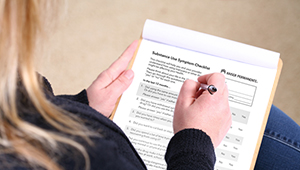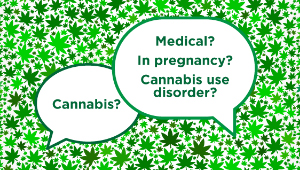Is medical use of cannabis as risky as nonmedical use?

New findings indicate medical cannabis use is associated with a lower risk of moderate to severe cannabis use disorder
More than half of U.S. adults now live in states where cannabis use is legal, and many people use it for both medical and nonmedical reasons. Prior research suggests medical use may be associated with a lower risk of addiction to cannabis (cannabis use disorder) than nonmedical use. Researchers at Kaiser Permanente Washington Health Research Institute (KPWHRI) studied whether people who use cannabis for medical reasons have lower risk of developing symptoms of cannabis use disorder than those who use cannabis for nonmedical reasons.
Results from a new study published in JAMA Network Open found that cannabis use disorder is common among primary care patients who use cannabis in Washington state. However, those who reported medical use only were less likely to report symptoms consistent with moderate to severe cannabis use disorder. The findings could help clinicians better engage with patients experiencing symptoms and provide helpful information to health care organizations that are beginning to screen for cannabis use.
“We wanted to conduct this study to help clinicians better understand whether it matters if patients report using cannabis for medical or nonmedical reasons, in terms of their risk for cannabis use disorder,” said Gwen Lapham, PhD, MSW, MPH, the lead author of the study. “Kaiser Permanente Washington has a behavioral health screening program that routinely asks primary care patients about cannabis use so that providers can know when patients are using cannabis, whether for medical or nonmedical reasons.”
Insights from routine cannabis screening
Adult use of cannabis for both medical and nonmedical purposes has been legal in Washington state since 2012, and Kaiser Permanente Washington began asking patients about their use in 2015. The researchers used data from surveys of a sample of primary care patients who completed a validated cannabis screen as part of their routine care between March and September 2019. The screen is a single question asking patients how often they used cannabis in the past year. Patients who reported using cannabis on the survey were asked how they typically used cannabis (for example, smoking, vaping, eating, topical use), the reason for use (medical, nonmedical, or both), and about symptoms of cannabis use disorder.
Out of 1,463 patients who answered the survey and reported recent cannabis use, 21% reported symptoms of either mild, moderate, or severe cannabis use disorder. About 1% of patients using cannabis only for medical reasons had moderate to severe symptoms. In contrast, over 7% of patients who reported any use of cannabis for nonmedical reasons, with or without medical use, reported experiencing moderate to severe symptoms of cannabis use disorder.
Cannabis use disorder is diagnosed when someone who uses cannabis experiences 2 or more symptoms. The 11 possible symptoms include cravings for cannabis, withdrawal if someone stops using cannabis, or experiencing problems with work or relationships that are caused by their cannabis use. If someone experiences 2 to 3 symptoms, that is considered mild cannabis use disorder. Moderate cannabis use disorder involves at least 4 symptoms, and more than 6 symptoms is considered severe.
“Many patients who use cannabis only for medical reasons reported that they applied cannabis topically, with lotions or ointments, as their primary mode of use, over smoking, vaping, or otherwise ingesting it, likely accounting for some of the lower risk,” said Kathy Bradley, MD, MPH, a senior investigator at KPWHRI and senior author of the study.
“In our sample, patients who use cannabis only for medical reasons, which was about 42% of survey respondents, had lower prevalence of moderate or severe cannabis use disorder,” Lapham said. “The question now is how to further understand a patient’s experiences with cannabis use in primary care.”
The results of this study underscore the importance of asking about cannabis use during routine health care visits, according to the researchers. “It’s really valuable for clinicians, because it offers an opportunity to engage with patients and start a conversation about whether their cannabis use is causing symptoms for them,” Lapham said.
Next steps
The research team has proposed work that would explore different ways of engaging patients with cannabis use disorder symptoms in primary care and supporting patients with moderate to severe symptoms. “We definitely believe in engaging patients in design, so part of that work would be speaking to patients about their needs and preferences,” Lapham said.
KPWHRI coauthors on the study are Tessa Matson, PhD; Jennifer Bobb, PhD; Casey Luce, MSPH; Malia Oliver, BA; and Leah Hamilton, PhD, MPhil. This research was supported by awards from the National Institute on Drug Abuse Clinical Trials Network.
By Amelia Apfel
KPWHRI In the media
Podcast: Frequency of cannabis use disorder in a state with legal use
Cannabis use disorder and reasons for use in a U.S. state where recreational cannabis use Is legal
JAMA Network Open Conversations, Aug. 29, 2023
innovating care

Asking patients about cannabis may benefit overall health
Drs. Lapham and Bradley find frequency of cannabis use can be tied to other behavioral health patterns and needs.
Research

Better tools for assessing substance use disorder
A simple checklist developed at KPWHRI does well at measuring symptoms of substance use disorder.
Research roundup

What's new in cannabis use research?
Use in pregnancy and screening in primary care studied by KPWHRI’s Kiel, Matson, and Lapham.



